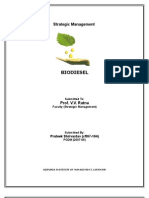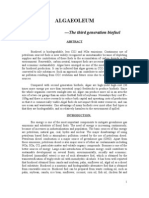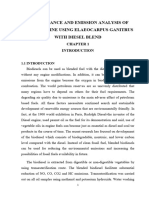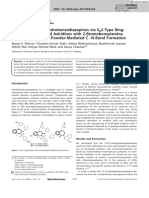Chemicals Used For Production
Chemicals Used For Production
Uploaded by
abdulmatinhublikarCopyright:
Available Formats
Chemicals Used For Production
Chemicals Used For Production
Uploaded by
abdulmatinhublikarOriginal Description:
Original Title
Copyright
Available Formats
Share this document
Did you find this document useful?
Is this content inappropriate?
Copyright:
Available Formats
Chemicals Used For Production
Chemicals Used For Production
Uploaded by
abdulmatinhublikarCopyright:
Available Formats
INTRODUCTION
Fossil fuels are one of the major sources of energy in the world today. Their popularity can be accounted to easy usability, availability and cost effectiveness. But the limited reserves of fossil fuels are a great concern owing to fast depletion of the reserves due to increase in worldwide demand. Fossil fuels are the major source of atmospheric pollution in todays world. So efforts are on to find alternative sources for this depleting energy source. Even though new technologies have come up which have made solar, wind or tidal energy sources easily usable but still they are not so popular due to problems in integration with existing technology and processes. So, efforts are being directed towards finding energy sources which are similar to the present day fuels so that they can be used as direct substitutes. Diesel fuel serves as a major source of energy, mainly in the transport sector.
CHEMICALS USED FOR PRODUCTION Biodiesel cannot produce without heat and without chemicals. The chemicals needed are few and easily obtained. However, it is necessary to take risk and must be handling carefully. Insure that the safety equipments listed in this report are available. 3.2.1. Sodium hydroxide Ensure that we use Sodium hydroxide (NaOH). While this is more expensive than sodium hydroxide, it dissolves much more easily in the methanol. NaOH of 85% purity and above can used, though the higher purity level, the better our process will work. 3.2.2. Methanol
Methanol is readily available in many different forms. Make sure that we get methanol and not ethanol: ethanol will not work for this process. In addition, check the manufactures label to ensure that it is methanol and not white gas. We should be able to find both chemicals through local stores. However, if we cannot locate them in our local area, the internet is handy source. Just ensure that we know the purity and contents of what we are purchasing. A repeatable source is vital for our production. 3.2.3. Phenolphthalein It is used as indicator in titration. Due to this indicator, mixture of 0.1NaOH and isopropyl alcohol with oil colour changes from colourless to pale pink
3.3. EQUIPMENTS USED FOR BIODIESEL PRODUCTION 3.3.1. HEATERThis is place inside, at the bottom of the container. To heat the pongamia and jatropha oil. 3.3.2. STIRRING EQUIPMENTS Used to mix the chemical products with oil. 3.3.3. THERMOMETERTo measure the temperature of products. 3.3.4. GLASS TUBE-
To measure the water level at the container. 3.3.5. BEAKERThis is used to prepare the methoxide. 3.3.6. CONTAINERThis is small container, in which we put all the products which are required to produce biodiesel.
Fossil fuels are one of the major sources of energy in the world today. Their popularity can be accounted to easy usability, availability and cost effectiveness. But the limited reserves of fossil fuels are a great concern owing to fast depletion of the reserves due to increase in worldwide demand. Fossil fuels are the major source of atmospheric pollution in todays world. So efforts are on to find alternative sources for this depleting energy source. Even though new technologies have come up which have made solar, wind or tidal energy sources easily usable but still they are not so popular due to problems in integration with existing technology and processes. So, efforts are being directed towards finding energy sources which are similar to the present day fuels so that they can be used as direct substitutes. Diesel fuel serves as a major source of energy, mainly in the transport sector. Fossil fuels are one of the major sources of energy in the world today. Their popularity can be accounted to easy usability, availability and cost effectiveness. But the limited reserves of fossil fuels are a great concern owing to fast depletion of the reserves due to increase in worldwide demand. Fossil fuels are the major source of atmospheric pollution in todays world. So efforts are on to find
alternative sources for this depleting energy source. Even though new technologies have come up which have made solar, wind or tidal energy sources easily usable but still they are not so popular due to problems in integration with existing technology and processes. So, efforts are being directed towards finding energy sources which are similar to the present day fuels so that they can be used as direct substitutes. Diesel fuel serves as a major source of energy, mainly in the transport sector. Bio-diesel is replacement fuel that is manufactured from vegetable oils, recycled cooking oils and animal fats. Because plants produced oils from sunlight and air, and we can do so year after year on crop land, these oils are renewable. Animal fats are produced when the animal consumes plant oils and other fats and they are renewable. As per ASTM, bio-diesel is chemical composed of mono alkyl ester as long chain fatty acids derived from vegetable oils and recycled cooking oils and animal fats. The bio-diesel thus obtained is designated at B100. Linseed oil, jathropa, sunflower oil, neem-oil are commonly used oil for production of bio-diesel.
offer plenty of space. Some come prewired for electricity, and have windows for ventilation, though this can also be added to other models. Regardless of where we decide to put our production equipment, ensure that there is plenty of room for the processor and other assorted necessities. 3.1.2. Safety Goggles These handy little devices will keep biodiesel, lye and methanol out of our eyes during production. Lye is specially caustic and can cause blindness if care is not exercised during use.
3.1.3. Chemical Resistant Apron Yes, it is necessary to wear an apron while concocting our fuel. By eliminating contact between skin/clothing and our chemicals, we can help ensure our safety. The apron chosen should be of vinyl and long enough to come just above our knees. 3.1.4. Protective Gloves Never, handle biodiesel or additives without the aid of heavy-duty protective gloves. In addition, rubber gloves are not a viable choice due to the corrosive effects of biodiesel on rubber. Nit riles PVC gloves are a good choice. These are disposable and should not degrade due to contact with biodiesel. 3.1.5. Heavy Clothing Finally, make sure that heavy clothing should be wear during production. Wear jeans, a long-sleeved shirt and appropriate foot wear. Heavier clothing helps eliminate inadvertent contact with biodiesel and associated chemicals. 3.1.6. Face mask Wearing a face mask can help reduce the amount of vapours we inhale. In addition never work with biodiesel without proper ventilation. Ensure that there are several open windows in our work area to allow vapours to be dissipated. A SCUBA apparatus is the best choice, as organic canisters do not filter out methanol fumes.
1. Seeds and leaves are toxic to human beings and animals
2. Toxicity is based on several components (phorbol esters, curcains, trypsin inhibitors and others) which make complete detoxification.
3. Incomplete combustion, characterized by nozzle choking, engine deposits, lubricating oil dilution, ring sticking, scuffing of the engine cylinder liners, injection nozzle failure and lubricant failure due to polymerization of the vegetable oil. By using Bio-diesel from renewable sources such as agriculture products, agro industry residues, Re cycled cooking oils; there is a reduction in the disposal costs of government and industry. Bio-diesel Reduces emissions. Bio-diesel is non-toxic, bio degradable. Blends of Bio- diesel accelerate the combustion process. The exhaust smells better than that of petrol diesel engine. It freezes at lower temperature. Bio-diesel has more energy, it has higher cetane rating. Bio-diesel gives lower engine wear.
By using Bio-diesel from renewable sources such as agriculture products, agro industry residues, Re cycled cooking oils; there is a reduction in the disposal costs of government and industry. Bio-diesel Reduces emissions. Bio-diesel is non-toxic, bio degradable. Blends of Bio- diesel accelerate the combustion process. The exhaust smells better than that of petrol diesel engine. It freezes at lower temperature. Bio-diesel has more energy, it has higher cetane rating. Bio-diesel gives lower engine wear. 1. Seeds and leaves are toxic to human beings and animals
2.
Toxicity is based on several components (phorbol esters, curcains, trypsin
inhibitors and others) which make complete detoxification.
3.
Incomplete combustion, characterized by nozzle choking, engine deposits,
lubricating oil dilution, ring sticking, scuffing of the engine cylinder liners, injection nozzle failure and lubricant failure due to polymerization of the vegetable oil.
4.
Brake thermal efficiency is lower, brake specific fuel consumption are
higher compared to diesel.
4. Exhaust emissions such as smoke, CO, and Un-burnt hydrocarbons emissions are higher compared to those of diesel. When the engine is 5. FUTURE SCOPE OF BIODIESEL 6. There are still more beneficial aspects to the production and use of biodiesel, in addition to the environmental pluses. These include: 7. Employment No product can be manufactured and delivered without employees, and biodiesel is no exception. Jobs ranging from farming to production to transportation would be created with development of biodiesel. 8. Decreased Dependence on Foreign Products- Almost every country is capable of producing bio diesel, albeit some with help from more developed countries. There no doubt that fuels independence increase domestic security and self - dependence. 9. Cost - While the initial cost of integrating bio diesel in to everyday life seem enormous, once that expense is addressed, the use of bio diesel would
be much less expensive than traditional fuel. Since production of biodiesel material is also controllable, you wouldnt find the same fluctuations in price as you do with oil and gasoline. 10.Greater Profits for farmers When biodiesel are made from crops, the farmers who grow these foods benefits as the prices of their crops increases to keep up with demand. This could help farmers all over the world, who have traditionally struggled to earn a fair wage for all of the work involved in their trade. 11.Many of the adverse effects of bio diesel on the environment could be reduced by using best agriculture management practices, if production is kept below sustainable production limits, although choice of feed stocks and the overall demand for biodiesel and level of production remain critical. 12.In general, biodiesel made from organic waste are environmentally more being than those from energy crops. Using biomass primarily for material purpose, reusing and recycling it, and then recovering its energy contents can gain multiple dividends.
You might also like
- Production of BioethanolDocument22 pagesProduction of BioethanolAniket Chaki100% (1)
- Chemistry Project On Green Chemistry: Bio-Diesel and Bio-PetrolDocument18 pagesChemistry Project On Green Chemistry: Bio-Diesel and Bio-PetrolFerry Sofat85% (20)
- Inrmation An FiursDocument9 pagesInrmation An FiursabdulmatinhublikarNo ratings yet
- Rsults T B CHCKDocument8 pagesRsults T B CHCKabdulmatinhublikarNo ratings yet
- Procedure and Experimental Setup: 3.1. Safety Steps Followed During ProductionDocument3 pagesProcedure and Experimental Setup: 3.1. Safety Steps Followed During ProductionabdulmatinhublikarNo ratings yet
- Uipmnt Us R Bisl RuctinDocument7 pagesUipmnt Us R Bisl RuctinabdulmatinhublikarNo ratings yet
- Green Chemistry - BiodieselDocument21 pagesGreen Chemistry - Biodieselkavikumar venkatajalamNo ratings yet
- ChemistryDocument5 pagesChemistrymerlynsosasajuNo ratings yet
- Paper Presentation Report: Anjalai Ammal Mahalingam Engineering CollegeDocument15 pagesPaper Presentation Report: Anjalai Ammal Mahalingam Engineering CollegeManjesh ThilakNo ratings yet
- 1827 ApprovedpaperDocument20 pages1827 ApprovedpaperMahtab SajnaniNo ratings yet
- Biofuel Fossil Fuel DifferencesDocument8 pagesBiofuel Fossil Fuel DifferencesmukundNo ratings yet
- Optimization of Biodiesel Production From Palm OilDocument3 pagesOptimization of Biodiesel Production From Palm OilNthabiseng Mo MalukeNo ratings yet
- Investigatory ProjectDocument16 pagesInvestigatory ProjectJaycee MeerandaNo ratings yet
- Assignment PaperDocument37 pagesAssignment Paperlshani KhannaNo ratings yet
- Project Proposal 9thDocument30 pagesProject Proposal 9thJonah Kimetto Kandaa100% (3)
- Biofuel and BiodieselDocument16 pagesBiofuel and Biodieseljoe100% (3)
- Biofuel: Biofuels Are A Wide Range of Fuels Which Are in Some Way Derived FromDocument16 pagesBiofuel: Biofuels Are A Wide Range of Fuels Which Are in Some Way Derived Fromsuniyoti100% (1)
- ALGAEOLEUMDocument7 pagesALGAEOLEUMS Bharadwaj ReddyNo ratings yet
- FL - Course 6Document22 pagesFL - Course 6Fianu AndreeaNo ratings yet
- Biodiesel Refers To A Non-Petroleum-Based Diesel Fuel Consisting of ShortDocument12 pagesBiodiesel Refers To A Non-Petroleum-Based Diesel Fuel Consisting of Shortchoureyshishir73No ratings yet
- Soap NutDocument9 pagesSoap NutkismuganNo ratings yet
- Evaluation of The Practicality of Home Biodiesel ProductionDocument12 pagesEvaluation of The Practicality of Home Biodiesel ProductiondionkantNo ratings yet
- Chapter 1 and 2 Pre OralDocument36 pagesChapter 1 and 2 Pre OralSherwin CruzNo ratings yet
- Discussion BiofuelDocument7 pagesDiscussion BiofuelSiti Humaira IbrahimNo ratings yet
- Coconut Oil Uses As Diesel FuelDocument6 pagesCoconut Oil Uses As Diesel Fueldavid_tomy_1No ratings yet
- Assignment Paper NewDocument37 pagesAssignment Paper Newlshani KhannaNo ratings yet
- Bio DiselDocument15 pagesBio DiselAmritansh JaiswalNo ratings yet
- Chemistry Project On Formation of BiodieselDocument3 pagesChemistry Project On Formation of BiodieselYamuna MehtaNo ratings yet
- The BiodeiselDocument107 pagesThe Biodeiselabdisahurisa24No ratings yet
- Chemistry Criterion D ResearchDocument7 pagesChemistry Criterion D ResearchNjeri GichangiNo ratings yet
- Biofuels FinalDocument4 pagesBiofuels Finalapi-326166436No ratings yet
- Anurag Final Report SVODocument43 pagesAnurag Final Report SVOArvind PandeyNo ratings yet
- Extracted Biodiesel As Feed For Internal Combustion EngineDocument8 pagesExtracted Biodiesel As Feed For Internal Combustion Enginekt rajaNo ratings yet
- Abhyodaya Siddhartha Xii - B Chemistry Lab 2010-2011: Master. of Class in The During The Year DateDocument29 pagesAbhyodaya Siddhartha Xii - B Chemistry Lab 2010-2011: Master. of Class in The During The Year Datejnvbidar40No ratings yet
- To Study The Production of Biodiesel Future FuelDocument12 pagesTo Study The Production of Biodiesel Future FuelAditya MishraNo ratings yet
- A Triple Helix Pte LTD Presentation 2011Document32 pagesA Triple Helix Pte LTD Presentation 2011Shreyas BhargavNo ratings yet
- Bio FuelDocument36 pagesBio FuelAmal ManojNo ratings yet
- Article PublicationDocument8 pagesArticle Publicationrikaseo rikaNo ratings yet
- Algae Biofuel AbhayDocument3 pagesAlgae Biofuel AbhaysandsomeNo ratings yet
- SadagobanDocument48 pagesSadagobanSolomon DurairajNo ratings yet
- The Next Generation Sustainable Fuel What Is Bio Diesel?Document4 pagesThe Next Generation Sustainable Fuel What Is Bio Diesel?rajpradhaNo ratings yet
- Biofuels 1Document17 pagesBiofuels 1Wajd NasserNo ratings yet
- GSOE9010 ProposalDocument4 pagesGSOE9010 ProposalShaheer Shabbir0% (1)
- Biofuel: A Type of Renewable Energy Source Derived From Microbial, Plant, or Animal MaterialsDocument9 pagesBiofuel: A Type of Renewable Energy Source Derived From Microbial, Plant, or Animal MaterialsVatsalaa ToshniwalNo ratings yet
- GREEN CHEMISTRY - Part-2Document12 pagesGREEN CHEMISTRY - Part-2Venkatesh PrasadNo ratings yet
- The Next Generation Sustainable Fuel: Jatropha CurcasDocument5 pagesThe Next Generation Sustainable Fuel: Jatropha CurcasAJER JOURNALNo ratings yet
- Automotive Repair and Its Environmental ImpactDocument10 pagesAutomotive Repair and Its Environmental Impactapi-287419690No ratings yet
- Submitted by P.Ramani: Jatropha OilDocument11 pagesSubmitted by P.Ramani: Jatropha Oilapi-19799369No ratings yet
- Ip ProjectDocument19 pagesIp ProjectSoham JadhavNo ratings yet
- Bio Diesel R & C 1 ReportDocument60 pagesBio Diesel R & C 1 Reportnstmd42zn2No ratings yet
- Project ReportDocument54 pagesProject Reportjadhavakshay610No ratings yet
- Biodiesel Raw Materials Can Be Inexpensive, Sometimes Free!: Vegetable OilsDocument5 pagesBiodiesel Raw Materials Can Be Inexpensive, Sometimes Free!: Vegetable Oilsinnocent2008No ratings yet
- Cost Summary PurcommDocument6 pagesCost Summary PurcommAhrvin Josh HortalNo ratings yet
- Chemistry Project Class 12Document17 pagesChemistry Project Class 12Aditya SahooNo ratings yet
- Mudit ChemmmmDocument21 pagesMudit ChemmmmPal WalkerNo ratings yet
- Paper 6 - IJERA 2013Document11 pagesPaper 6 - IJERA 2013KrishnaMurthyTPNo ratings yet
- Liquid Fuels For Transportation: Biofuels Are A Wide Range of Fuels Which Are in Some Way Derived FromDocument11 pagesLiquid Fuels For Transportation: Biofuels Are A Wide Range of Fuels Which Are in Some Way Derived FromsadhanasvceNo ratings yet
- Biofuels: Juan Ayala, Leah Lawrence, K'Shaunna Ross, Christopher EstradaDocument12 pagesBiofuels: Juan Ayala, Leah Lawrence, K'Shaunna Ross, Christopher EstradaLeah-OliviaNo ratings yet
- Biodiesel Production101: Homebrew Edition: A Do It Yourself Guide to Produce Biodiesel on Your BackyardFrom EverandBiodiesel Production101: Homebrew Edition: A Do It Yourself Guide to Produce Biodiesel on Your BackyardNo ratings yet
- Biodiesel: Using Renewable Resources: IntroductionDocument3 pagesBiodiesel: Using Renewable Resources: IntroductionElla Camille DinogyaoNo ratings yet
- Thermals y LLDocument20 pagesThermals y LLabdulmatinhublikarNo ratings yet
- Ia 2 Nces QPDocument1 pageIa 2 Nces QPabdulmatinhublikarNo ratings yet
- 1st IA EnergyDocument1 page1st IA EnergyabdulmatinhublikarNo ratings yet
- Energy Question Paper Ist InternalDocument2 pagesEnergy Question Paper Ist InternalabdulmatinhublikarNo ratings yet
- New Microsoft Word Document (489Document2 pagesNew Microsoft Word Document (489abdulmatinhublikarNo ratings yet
- There Are Two Types of Air Preheahers: Course OutcomesDocument2 pagesThere Are Two Types of Air Preheahers: Course OutcomesabdulmatinhublikarNo ratings yet
- Department of Mechanical EngineeringDocument2 pagesDepartment of Mechanical EngineeringabdulmatinhublikarNo ratings yet
- Department of Mechanical Engineering Sub: Books For Department LibraryDocument4 pagesDepartment of Mechanical Engineering Sub: Books For Department LibraryabdulmatinhublikarNo ratings yet
- P.A. College of Engineering Mangalore Department of Mechanical Engineering Sub: Books For Department LibraryDocument4 pagesP.A. College of Engineering Mangalore Department of Mechanical Engineering Sub: Books For Department LibraryabdulmatinhublikarNo ratings yet
- Department of Mechanical Engineering: SL No Title of Book Author Publication No of CopiesDocument2 pagesDepartment of Mechanical Engineering: SL No Title of Book Author Publication No of CopiesabdulmatinhublikarNo ratings yet
- Book List1111Document2 pagesBook List1111abdulmatinhublikarNo ratings yet
- SL No Title of Book Author Publication No of Copies: Department of Mechanical EngineeringDocument2 pagesSL No Title of Book Author Publication No of Copies: Department of Mechanical EngineeringabdulmatinhublikarNo ratings yet
- Book List Heeat TransfDocument1 pageBook List Heeat TransfabdulmatinhublikarNo ratings yet
- A Ne W PH en o Me No Lo Gic Al Cri Ter Io N For Pel Let - Cla DD in GDocument4 pagesA Ne W PH en o Me No Lo Gic Al Cri Ter Io N For Pel Let - Cla DD in GabdulmatinhublikarNo ratings yet
- Everyday Science 2005 PDFDocument5 pagesEveryday Science 2005 PDFMuhammad MidhatNo ratings yet
- Crude OilDocument51 pagesCrude OilJeyaraj Anand100% (6)
- Test Request Form: Requested Test (Put "X" To Check)Document2 pagesTest Request Form: Requested Test (Put "X" To Check)Claudia Lizeth Chacon PedrazaNo ratings yet
- Diels Alder Reactions Stereo AspectsDocument19 pagesDiels Alder Reactions Stereo AspectssaheedvkNo ratings yet
- 1251 Weighing On An Analytical Balance: IdentificationDocument5 pages1251 Weighing On An Analytical Balance: IdentificationOsama MahmoudNo ratings yet
- Asian J. Org. Chem. 2015, 4, 1103 - 1111Document9 pagesAsian J. Org. Chem. 2015, 4, 1103 - 1111RohanNo ratings yet
- Learning ObjectivesDocument19 pagesLearning Objectivesfred gallardoNo ratings yet
- Air Dryer ManualDocument40 pagesAir Dryer Manualashwa3042No ratings yet
- Suction Scrubber Discharge Scrubber: Production SeparatorDocument2 pagesSuction Scrubber Discharge Scrubber: Production SeparatorHtoo Htoo KyawNo ratings yet
- Template Synthesis of Nanomaterials PDFDocument20 pagesTemplate Synthesis of Nanomaterials PDFVandam65No ratings yet
- Biosep Short OverviewDocument9 pagesBiosep Short OverviewMeyakorberNo ratings yet
- Mil C 45224DDocument27 pagesMil C 45224Dvigneshwaran50100% (1)
- PTSI Office Papua 2023Document2 pagesPTSI Office Papua 2023Fahmi YusaNo ratings yet
- Dunlop Rubber Cover Grade QualitiesDocument1 pageDunlop Rubber Cover Grade Qualitiesjonodo89No ratings yet
- Alkaline Non-Cyanide ZincDocument4 pagesAlkaline Non-Cyanide ZincSuraj RawatNo ratings yet
- Class 9th AssignmentDocument4 pagesClass 9th Assignmentpalakmishra.facNo ratings yet
- Att3 The Quality Standard of Wasteindustrial WaterDocument2 pagesAtt3 The Quality Standard of Wasteindustrial WaterpermanaaprialNo ratings yet
- P & P EnglishDocument26 pagesP & P EnglishmissaouiNo ratings yet
- 1 IntroductionDocument7 pages1 IntroductionDangolNo ratings yet
- Crushing Test PDFDocument4 pagesCrushing Test PDFAshishJamadar100% (1)
- Mustapha Et Al. (2022)Document8 pagesMustapha Et Al. (2022)Alhassan I MohammedNo ratings yet
- CSWIP 3.1 Question With Answer and Explanation - Part 12Document9 pagesCSWIP 3.1 Question With Answer and Explanation - Part 12adel100% (4)
- Professional Silicone Sealants: Dow CorningDocument4 pagesProfessional Silicone Sealants: Dow CorninggabyorNo ratings yet
- Chemistry ProjectDocument8 pagesChemistry Projectmonelmetal50% (2)
- Utilization of Brine Sludge in Non-Traffic Paver Blocks: by Gaurav PathakDocument21 pagesUtilization of Brine Sludge in Non-Traffic Paver Blocks: by Gaurav PathakgauravNo ratings yet
- Propoxur Mechanism of ToxicityDocument2 pagesPropoxur Mechanism of ToxicityDesye MeleseNo ratings yet
- 16 TH PPT of Foods and Industrial MicrobiologyCourse No. DTM 321Document16 pages16 TH PPT of Foods and Industrial MicrobiologyCourse No. DTM 321jeevalakshmanan29No ratings yet
- Advanced Pump DiagnosticsDocument8 pagesAdvanced Pump DiagnosticsSteven A McMurrayNo ratings yet
- Chemical Kinetics Typed Notes STUDY RATEDocument33 pagesChemical Kinetics Typed Notes STUDY RATEYASH SONARNo ratings yet
- 1.1 Proteins - Motifs Structural and Functional Domains Protein FamiliesDocument32 pages1.1 Proteins - Motifs Structural and Functional Domains Protein FamilieskinjalkaNo ratings yet







































































































